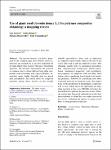Item Infomation
Full metadata record
| DC Field | Value | Language |
|---|---|---|
| dc.contributor.author | Luis Suárez, Ortega Zaida Ortega | - |
| dc.contributor.author | Mateusz, Barczewski | - |
| dc.contributor.author | Eoin, Cunningham | - |
| dc.date.accessioned | 2023-04-21T03:03:23Z | - |
| dc.date.available | 2023-04-21T03:03:23Z | - |
| dc.date.issued | 2023 | - |
| dc.identifier.uri | https://link.springer.com/article/10.1007/s10570-023-05176-x | - |
| dc.identifier.uri | https://dlib.phenikaa-uni.edu.vn/handle/PNK/8191 | - |
| dc.description | CC BY | vi |
| dc.description.abstract | The massive biomass availability generated by the common giant reed (Arundo donax L.) motivates the research for its possible industrial use for high-added-value products through a biorefinery approach. The literature demonstrates the potential of common cane to obtain different high-value compounds, such as levulinic acid, oligosaccharides, fermentable sugars, highly digestible fiber for animal feed, polyphenols, and natural fibers for composite materials, among others. Arundo can also provide valuable lignocellulosic fibers with an application as composite reinforcement, which is the aim of this review. The work is split into different sections: fiber obtaining, mainly done by mechanical procedures, fiber characterization (composition, thermal degradation, "mechanical properties", and crystallinity), and properties of composites with reed fiber. | vi |
| dc.language.iso | en | vi |
| dc.publisher | Springer | vi |
| dc.subject | Arundo donax L. | vi |
| dc.subject | mechanical properties | vi |
| dc.title | Use of giant reed (Arundo donax L.) for polymer composites obtaining: a mapping review | vi |
| dc.type | Book | vi |
| Appears in Collections | ||
| OER - Khoa học Tự nhiên | ||
Files in This Item:

